The Intel Ivy Bridge (Core i7 3770K) Review
by Anand Lal Shimpi & Ryan Smith on April 23, 2012 12:03 PM EST- Posted in
- CPUs
- Intel
- Ivy Bridge
The Lineup: Quad-Core Only for Now
Very telling of how times have changed is that today's Ivy Bridge launch only comes with a single Extreme Edition processor—the Core i7-3920XM, a mobile part. There are some great enthusiast desktop parts of course, but as with Sandy Bridge the desktop Extreme Edition is reserved for another platform. In this case, we're talking about LGA-2011 which won't launch in an Ivy flavor until the end of this year/early next year at this point.
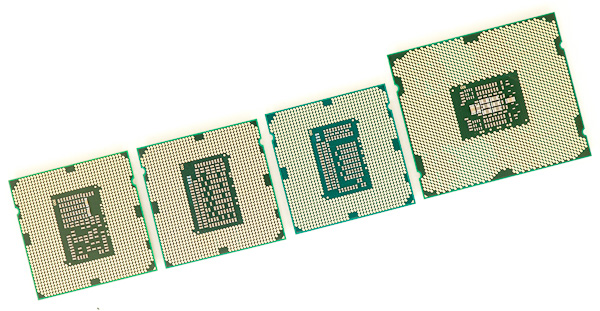
From left to right: Clarkdale, Sandy Bridge, Ivy Bridge, Sandy Bridge E
Contrary to everything I've been saying thus far however is the nature of the launch: only quad-core parts will be available first. The dual-core, and more importantly for Ivy Bridge, the ultra low voltage parts won't come until May/June. That means the bigger notebooks and naturally the performance desktops will arrive first, followed by the ultraportables, Ultrabooks and more affordable desktops. This strategy makes sense as the volumes for expensive quad-core notebooks and performance desktops in general are lower than cheaper dual-core notebooks/desktops. From what I've heard, the move to 22nm has been the most challenging transition Intel's fab teams have ever faced, which obviously constrains initial supplies.
| Intel 2012 CPU Lineup (Standard Power) | |||||||||
| Processor | Core Clock | Cores / Threads | L3 Cache | Max Turbo | Intel HD Graphics | TDP | Price | ||
| Intel Core i7 3960X | 3.3GHz | 6 / 12 | 15MB | 3.9GHz | N/A | 130W | $999 | ||
| Intel Core i7 3930K | 3.2GHz | 6 / 12 | 12MB | 3.8GHz | N/A | 130W | $583 | ||
| Intel Core i7 3820 | 3.6GHz | 4 / 8 | 10MB | 3.9GHz | N/A | 130W | $294 | ||
| Intel Core i7 3770K | 3.5GHz | 4 / 8 | 8MB | 3.9GHz | 4000 | 77W | $313 | ||
| Intel Core i7 3770 | 3.4GHz | 4 / 8 | 8MB | 3.9GHz | 4000 | 77W | $278 | ||
| Intel Core i5 3570K | 3.4GHz | 4 / 4 | 6MB | 3.8GHz | 4000 | 77W | $212 | ||
| Intel Core i5 3550 | 3.3GHz | 4 / 4 | 6MB | 3.7GHz | 2500 | 77W | $194 | ||
| Intel Core i5 3450 | 3.1GHz | 4 / 4 | 6MB | 3.5GHz | 2500 | 77W | $174 | ||
| Intel Core i7 2700K | 3.5GHz | 4 / 8 | 8MB | 3.9GHz | 3000 | 95W | $332 | ||
| Intel Core i5 2550K | 3.4GHz | 4 / 4 | 6MB | 3.8GHz | N/A | 95W | $225 | ||
| Intel Core i5 2500 | 3.3GHz | 4 / 4 | 6MB | 3.7GHz | 2000 | 95W | $205 | ||
| Intel Core i5 2400 | 3.1GHz | 4 / 4 | 6MB | 3.4GHz | 2000 | 95W | $195 | ||
| Intel Core i5 2320 | 3.0GHz | 4 / 4 | 6MB | 3.3GHz | 2000 | 95W | $177 | ||
There are five 77W desktop parts launching today, three 65W parts and one 45W part. The latter four are either T or S SKUs (lower leakage, lower TDP and lower clocked parts), while the first five are traditional, standard power parts. Note that max TDP for Ivy Bridge on the desktop has been reduced from 95W down to 77W thanks to Intel's 22nm process. The power savings do roughly follow that 18W decrease in TDP. Despite the power reduction, you may see 95W labels on boxes and OEMs are still asked to design for 95W as Ivy Bridge platforms can accept both 77W IVB and 95W Sandy Bridge parts.
We've already gone through Ivy's architecture in detail so check out our feature here for more details if you haven't already.
| Intel 2012 Additional CPU Features (Standard Power) | |||||||||
| Processor | GPU Clock (base) | GPU Clock (max) | PCIe 3.0 | Intel SIPP | Intel vPro | Intel VT-d | Intel TXT | ||
| Intel Core i7 3770K | 650MHz | 1150MHz | Yes | No | No | No | No | ||
| Intel Core i7 3770 | 650MHz | 1150MHz | Yes | Yes | Yes | Yes | Yes | ||
| Intel Core i5 3570K | 650MHz | 1150MHz | Yes | No | No | No | No | ||
| Intel Core i5 3550 | 650MHz | 1150MHz | Yes | Yes | Yes | Yes | Yes | ||
| Intel Core i5 3450 | 650MHz | 1100MHz | Yes | Yes | Yes | Yes | Yes | ||
The successful K-series SKUs are front and center in the Ivy lineup. As you'll remember from Sandy Bridge, anything with a K suffix ships fully unlocked. Ivy Bridge K-series SKUs support multipliers of up to 63x, an increase from the 57x maximum on Sandy Bridge. This won't impact most users unless you're doing any exotic cooling however.
If you don't have a K in your product name then your part is either partially or fully locked. Although this doesn't apply to any of the CPUs launching today, Ivy Bridge chips without support for turbo are fully locked and cannot be overclocked.
If your chip does support turbo boost, then you can overclock via increasing turbo ratios by as much as 4 bins above their standard setting. For example, the Core i7 3550 has a max turbo frequency of 3.7GHz with a single core active. Add another four bins (4 x 100MHz) and you get a maximum overclock of 4.1GHz, with one core active. The other turbo ratios can also be increased by up to four bins.
| Sandy Bridge vs. Ivy Bridge Pricing | |||||
| Sandy Bridge | Price | Price | Ivy Bridge | ||
| Core i7 2700K | $332 | $313 | Core i7 3770K | ||
| Core i7 2600 | $294 | $278 | Core i7 3770 | ||
| Core i5 2550K | $225 | $212 | Core i5 3750K | ||
| Core i5 2500 | $205 | $194 | Core i5 3550 | ||
| Core i5 2400 | $184 | $174 | Core i5 3450 | ||
The 3770K is the new king of the hill and it comes in $19 cheaper than the hill's previous resident: the Core i7 2700K. The non-K version saves you $16 compared to Sandy Bridge. The deltas continue down the line ranging ranging from $10—$19.
Unlike the Sandy Bridge launch, Intel is offering its high-end GPU on more than just K-series desktop parts right away. It is also differentiating K from non-K by adding another 100MHz to the base clock for K series parts. While the Core i7 2600K and Core i7 2600 both ran at 3.3GHz, the 3770 runs at 3.4GHz compared to the 3770K's 3.5GHz. It's a small difference but one that Intel hopes will help justify the added cost of the K.
Classic feature segmentation is alive and well with Ivy Bridge. In the quad-core lineup, only Core i7s get Hyper Threading—Core i5s do not. When the dual-core Core i3s show up in the coming months they will once again do so without support for turbo boost. Features like VT-d and Intel TXT are once again reserved for regular, non-K-series parts alone.


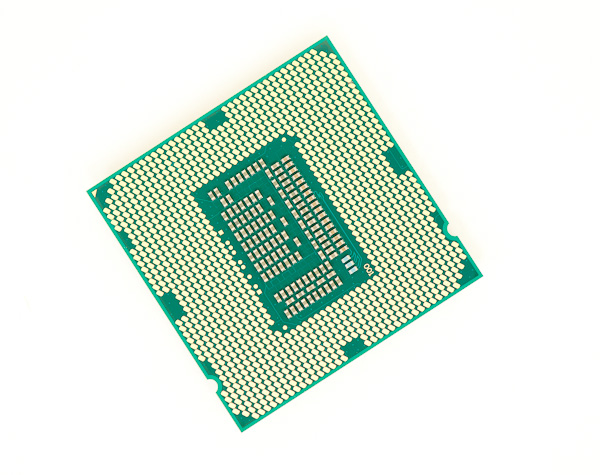
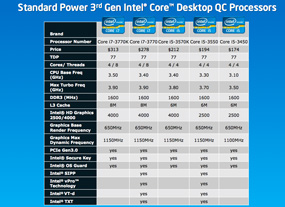
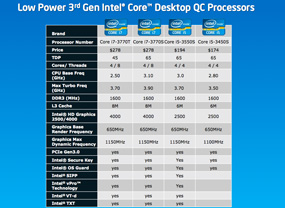
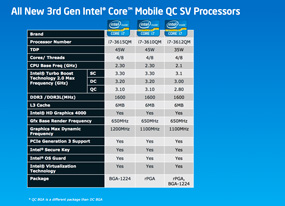
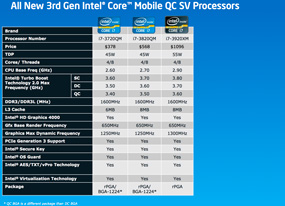








173 Comments
View All Comments
frozentundra123456 - Monday, April 23, 2012 - link
According to the Asus review just out by Anand, the Intel HD4000 and AMD HD6620 are essentially even in the mobile space, where it really matters. I dont know where you are getting the "soundly trounces" description, unless you are talking about the desktop. I dont really care about integrated graphics on the desktop, it is just too easy to add a discrete card that soundly trounces either Intel or AMD integrated. I have no doubt that AMD will regain the lead in the mobile space when Trinity comes out. I just question that they will make the kind of improvements that are being speculated about.I also find it ironic that so many people are criticizing IVB for lack of cpu improvement while in the same breath saying bulldozer is OK because it is "good enough" already.
DanNeely - Monday, April 23, 2012 - link
Primarily Einstein@Home.fastman696 - Monday, April 23, 2012 - link
Thanks for the review, but this is new Tech, why use old Tech chipset?JarredWalton - Monday, April 23, 2012 - link
You're being deliberately obtuse in order to set up a straw man.Me: "As I note in the mobile IVB article, mobile Llano GPU performance isn't nearly as impressive relative to IVB as on the desktop."
You: "The mobile variant of the part that launched last year isn't as dominant over the part that just launched today as the desktop variant is?"
In other words, you want us to compare to a product that's not out because the current product doesn't look good. I mention Trinity already, but you act as though I miss it. Then you throw out stuff like, "Thanks for resorting to namecalling" when you've already been insulting with your comments since the get go. "Sad to see this kind of crap coming from Anandtech." "I guess Anandtech's standards have drastically lowered." Put another way, you're already calling me an idiot but doing it indirectly. But let's continue....
How much faster can you do Flash video when it's already accelerated and working properly in Sandy Bridge? Web browsers are basically in the same boat, unless you can name major web sites that a lot of users visit where HD 3000/4000 is significantly worse than the competition.
Does Photoshop benefit from GPUs? Sure, and lots of people use that, including me, but the same people that use Photoshop are also the people who need more than Llano CPU performance, and more than HD 4000 or Llano or Trinity GPU performance. I'm running Bloomfield with a GTX 580, which is more than 95% of users out there. Most serious Photoshop users that I know use quad-core Intel with some form of NVIDIA graphics for a reason. But even running on straight Sandy Bridge with HD 3000, Photoshop runs faster than on Llano with HD 6620G.
Vegas, naturally, is in the same category as video transcoding. I suppose I could have said "video editing/transcoding" just to be broader. There are tons of people that don't do video editing/transcoding. Even for those that do, NVIDIA GPUs are doing far better than AMD GPUs, and NVIDIA + Intel CPU is still the platform to beat. If you want quality, though, encoding is still done in software running on the CPU; Premiere for instance really just leverages the GPU to help with the "quick preview" videos, not for final rendering (unless something has changed since the last time I played with it).
So let's try again: what exactly are the areas where Intel's Ivy Bridge and HD 4000 fall short, where AMD's Llano (or the upcoming Trinity) are going to be substantially better? All without adding a discrete GPU. Llano is equal to HD 4000 for gaming, and seriously behind on the CPU department. There are still areas where AMD's drivers are much better than Intel's drivers, and there are certain tasks (shader and geometry) where AMD is better. Really, though, the only area where Intel doesn't compete is in strictly budget laptops.
chizow - Monday, April 23, 2012 - link
Yes I have heard of a "tick", and IVB has manifested itself as a tick+ as indicated in the article which means we are basically on the 3rd generation of the same architecture introduced with Nehalem in late 2008 with some minor bumps in clockspeed/Turbo modes and overclocking headroom.Both Conroe and Nehalem were pretty huge jumps in performance only 2.5 years apart on one of Intel's Tick Tock cadence cycles and since then, nothing remotely as interesting.
Maybe you should be asking yourself why you aren't expecting bigger performance gains? Or maybe you're still reveling and ogling over Tahiti's terrible price:performance gains in the GPU space? :D
JarredWalton - Monday, April 23, 2012 - link
Yes, because that extra 10W TDP makes all the difference, doesn't it? 45W Llano parts aren't shipped in very many laptops because the OEMs aren't interested. Just look at Newegg as an example:http://www.newegg.com/Product/ProductList.aspx?Sub...
There is one current A8 APU faster than the A8-3520M for sale at Newegg, and it has an A8-3510MX. AMD's own list isn't much better (http://shop.amd.com/us/All/Search?NamedQuery=visio... there's one more notebook there with an A8-3530MX. So that's why we looked at A8-3520M, but if I had an MX chip I would certainly run the same tests -- no one has been willing to send us such a laptop, unfortunately.
But even if we got an MX chip, their GPUs are still clocked the same as the A8-3500M/A8-3520M. We might be CPU limited in a couple games, but while there are Llano parts with 20% higher CPU clocks, that just means Intel is "only" ahead by 60-70% instead of 100% faster on CPU performance.
Joepublic2 - Monday, April 23, 2012 - link
Because stock temperatures are irrelevant (much like your posting) to the end user as long as the chip isn't throttling.samal90 - Monday, April 23, 2012 - link
you people over-analyzed my comment. All I wanted to say is that they are bragging about HD 4000 when it doesn't come close to the current competition.Couple of years down the road, people won't want dedicated graphics cards in their laptops anymore..its too bulky and consumes too much power. We will all have integrated GPUs. the AMD APU is the way to go. To be honest, CPU power is already way more than enough for a lot of things most people use their laptops for (browsing the web, writing documents, play web-based games a.k.a. angry birds on chrome). The extra GPU is for people that either want to do some graphics processing or play some more graphics intensive games. So yes, it is important for the future to have a good and strong integrated GPU and a good CPU. Therefore, I think AMD will win this round. I hope they continue to compete at each other's throats so we see better and cheaper products from both sides.
So as I understand it right now: Go for AMD if you want better GPU, go for Intel if CPU is more important for you. Trinity might narrow the CPU gap however and greatly increase the GPU one. Only time will tell.
chaos215bar2 - Tuesday, April 24, 2012 - link
"Ivy Bridge is hotter, so if you're paying for the AC, it should be a negative impact."Where do you think the dissipated power is going? TDP and overall thermal output are roughly equivalent.
IVB may get hotter, but without measuring TDP overclocked and under load, that could easily be because the die is smaller and doesn't dissipate heat quite as well.
DanNeely - Tuesday, April 24, 2012 - link
"I don't understand this. We're talking about power consumption, not TDP. Heat-wise, Ivy Bridge is hotter, so if you're paying for the AC, it should be a negative impact."Power consumption is TDP. 100W of power is 100joules/second of heat to be disipated; it doesn't matter if the heat's coming off a large warm die, or a small hot one. 100W is 100W.
My current i7-9xx boxes are 130W chips; so just looking at TDP somewhere between 60 and 90W less power at stock (~50 just from the CPU TDP, the higher number the chipset's a theoretical 18 more, probably a lot less in practice, and then whatever cut of the IB's TDP is for the GPU). Probably a wider gap when OCed, but I don't have any stock vs OC power numbers to look at. With AC costs added, cost savings would probably be between $100 and $200/year per box.
Up front costs would be ~$400-550 for CPU + mobo pairs depending on how high up the feature chain I went; probably fairly high for my main box and more bang for the buck on the 2nd.
Looking on ebay for successful auctions it looks like I could get ~$250 for my existing cpu/mobo pairs less whatever ebay's fee is. The very rough guess would be a 2 yearish payback time which is somewhat better that I thought (closer to 3 years).
Not sure I'll do it since I have a few other PC related purchases on the wishlist too: replacing my creaky Core One Duo laptop with a light/medium gaming model or swapping out my netbook for a new ultra portable after Win8 launches might give better returns for my dollar. The latter's battery isn't really lasting as long as I'd like any more. Also, my WHSv1 box is scheduled for retirement this winter.
I am going to have to give it some serious thought though. Part of me still wants to wait for Haswell even though preliminary indications are that it won't be a huge step up; the much bigger GPU and remaining at dual channel memory makes a mainstream hex core part unlikely.